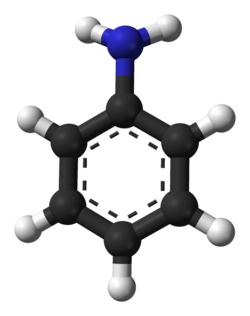
Back Amien Afrikaans أمين (كيمياء) Arabic Amina AST Aminlər Azerbaijani Аміны Byelorussian Аміны BE-X-OLD Амин Bulgarian অ্যামিন Bengali/Bangla Amin (hemija) BS Amina Catalan

In chemistry, amines (/əˈmiːn, ˈæmiːn/,[1][2] UK also /ˈeɪmiːn/[3]) are organic compounds that contain carbon-nitrogen bonds.[4] Amines are formed when one or more hydrogen atoms in ammonia are replaced by alkyl or aryl groups.[5] The nitrogen atom in an amine possesses a lone pair of electrons. Amines can also exist as hetero cyclic compounds. Aniline () is the simplest aromatic amine, consisting of a benzene ring bonded to an amino (–) group.[6][7]

Amines are classified into three types: primary (1°), secondary (2°), and tertiary (3°) amines. Primary amines (1°) contain one alkyl or aryl substituent and have the general formula . Secondary amines (2°) have two alkyl or aryl groups attached to the nitrogen atom, with the general formula . Tertiary amines (3°) contain three substituent groups bonded to the nitrogen atom, and are represented by the formula .[8]
The functional group −NH2 present in primary amines is called the amino group.[9]
- ^ "amine". The American Heritage Dictionary of the English Language (5th ed.). HarperCollins.
- ^ "Amine definition and meaning". Collins English Dictionary. Archived from the original on 23 February 2015. Retrieved 28 March 2017.
- ^ "amine – definition of amine in English". Oxford Dictionaries. Archived from the original on 23 February 2015. Retrieved 28 March 2017.
- ^ Anderson, Gregory; Fahey, Caryn; Richards, Adrienne; Sauer, Samantha Sullivan; Wegman, David; Booth, Jen (16 February 2024). "26.1 Amines – Structure and Naming". Open Library.
- ^ Bhuyan, Satyam (25 August 2023). "Amines: Definition, Structure, Type, and Example". Chemistry Learner. Retrieved 27 May 2025.
- ^ PubChem. "Aniline". pubchem.ncbi.nlm.nih.gov. Retrieved 27 May 2025.
- ^ Cite error: The named reference
Ullmannwas invoked but never defined (see the help page). - ^ Lyons, Kate. "LibGuides: CHE 120 - Introduction to Organic Chemistry - Textbook: Chapter 5 - Amines and Amides". guides.hostos.cuny.edu. Retrieved 27 May 2025.
- ^ Smith, Janice Gorzynski (2011). "Chapter 25 Amines". Organic chemistry (3rd ed.). New York, NY: McGraw-Hill. pp. 949–993. ISBN 978-0-07-337562-5. Archived from the original (Book) on 28 June 2018. Retrieved 26 June 2018.
© MMXXIII Rich X Search. We shall prevail. All rights reserved. Rich X Search




